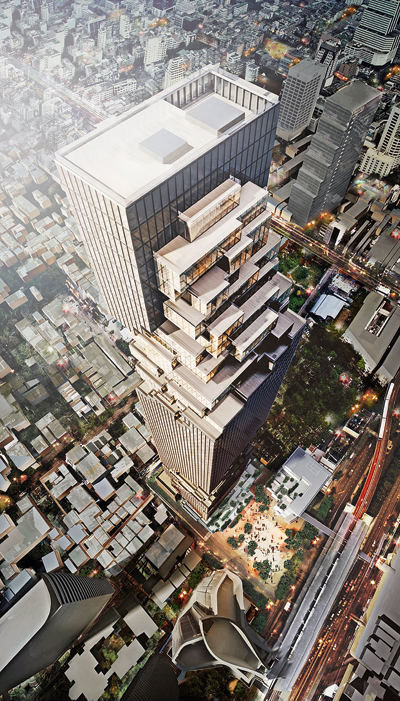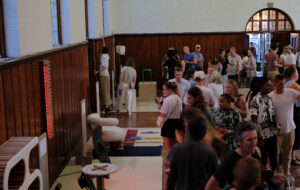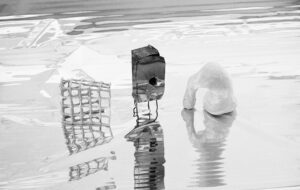|
Ole Scheeren, one of architecture’s brightest talents, left OMA in 2010 to found his own practice. Last year, he talked to Icon about CCTV, his plans for more Asian towers, and his first realised project: a floating cinema in a picturesque bay in Thailand This article was first published in Icon’s August 2012 issue: Boats, under the headline “Lord of towers”. Buy old issues or subscribe to the magazine for more like this Two years ago (in 2010) Ole Scheeren left OMA, where he had worked for 15 years, to set up his own practice. “When I was 18, I thought I can’t possibly not work for Rem,” the 40-year-old German architect says. “It was a very impulsive moment, I just showed up there and asked for a job. I felt that they were doing something that I wasn’t able yet to articulate in the same way: they had a particular way of looking at and thinking about the world to create a far more contradictory synthesis of things.” Rem Koolhaas put him to work designing the facade of a shopping mall and Scheeren, whose father was an architect in Karlsruhe, became a faithful acolyte, joining the firm full-time in 1995 and working his way swiftly through the ranks.”He never gave advice, he gave opportunities,” Scheeren says of his mentor. At that time there were only 30 people working in OMA’s Rotterdam office, but the firm quickly grew around him. “It was an extremely intense and small place … In many ways beautifully unprofessional, and in many ways beautifully radical,” he says. “Over those 15 years, the office grew to 200, 250, 300 people. Managing directors came in from the banking world, in-house lawyers from Wall Street, and suddenly the office became a very different place.” A decade ago, Scheeren left the Netherlands to become director of OMA Asia, setting up an office in Beijing (which eventually employed 40 people) to steward the prestigious China Central Television (CCTV) headquarters into existence. “I wanted to take responsibility for the idea we had come up with and engage more thoroughly with Asia in multiple ways,” he says. “All the western architects were doing stuff at home and sending over drawings. This project could have never happened that way – it was way too challenging.” CCTV – nicknamed by locals “the big pants” – was completed for the 2008 Olympics in the city but having suffered a fire and because of the laborious process of installing broadcast technology (the budget for which was almost as much as for the building), it officially opened in May this year. From Beijing, enjoying an explosion of development in Asia, Scheeren spearheaded OMA schemes in Thailand, Singapore, Taipei and other places. “It was an incredible platform, relationship and collaboration,” Scheeren says, reflecting on his time at the firm. “But after 15 years there is the question: what was that? What lies ahead of you? How do you see your own future? For the first time there was a sense of maturity and a sense of true excitement with the idea that everything could be open again.” The first project announced by Buro Ole Scheeren, which already employs as many people as OMA’s Beijing office, was a soaring, tropical tower in Kuala Lumpur – as ambitious in size as CCTV. When we meet in London (in January and again in May), Scheeren tells me with some embarrassment that in Germany he is known as Herr der Türme: Lord of Towers. However, Scheeren – who has chiselled, boyish features and speaks with articulate enthusiasm – is keen to deconstruct his image as a skyscraper man; he wants to define his new office by working at both ends of the scale. Indeed, his studio’s first realised structure is a small floating cinema, designed for a Thai film festival curated by actress Tilda Swinton and director Apichatpong Weerasethakul (winner of the Palme d’Or at the 2010 Cannes Film Festival). “Speed is one of the great feats of something like that,” he says of the $50,000 project. “You can make it happen within a few weeks, while architecture is always condemned to take at least half a decade.” He explains more about his Archipelago Cinema: “They wanted to show films out in the middle of nowhere, in the incredible beauty of the Thai ocean. I went out there [to Kudu Island near Phuket, Thailand] and it’s somehow really difficult when confronted by such an obscenely beautiful landscape. The thought of doing anything, especially as an architect, is rather painful, if not completely implausible.” Scheeren decided to create a floating platform that would place visitors amid the striking scenery. He travelled around meeting local fisherman to find out how this might be done, finding inspiration in the lobster farms that were built by wrapping big blocks of salvaged packing material in mosquito nets, which were tied with bands cut from old tyres. Employing local labour, Scheeren created a series of 5m x 5m rafts using this technique, which were covered in recycled wood and fitted together to create a “loosely assembled, driftwood, ephemeral, temporary structure”. The series of tectonic plates, fitted together like a jigsaw, moved with the water to create an auditorium with 120 seats that was in a constant state of gentle flux. Only the projector and screen were firmly anchored to the ocean floor. Cinemagoers travelled 20 minutes by boat to Phang Nga Bay, where silent movies were screened – a 1904 version of Alice in Wonderland, a 1924 edition of Peter Pan and Warhol’s 1964 tribute to the Empire State Building – to live musical accompaniment by Simon Fisher Turner. Guests arrived in complete darkness, and only at the end of the screening was lighting used to illuminate the dramatic setting – a beautiful, lush cove with jagged 100m-high rock outcroppings
The 314m MahaNakhon will be the tallest building in Bangkok At the other end of the scale are Scheeren’s arresting towers in Kuala Lumpur and Bangkok. Both, in their way, seek to adapt the skyscraper to a tropical setting by creating plinths that don’t repel the city with their blank facades but suck in its greenery, rooting the building firmly in urban street life. The ground floors of the 268m Angkasa Raya, for example, which will stand in the shadow of Kuala Lumpur’s Petronas Twin Towers (the tallest buildings in the world from 1998-2004), resemble Herzog & de Meuron’s Miami car park, 1111 Lincoln Road. The Swiss architects described their building as a reinterpretation of “tropical modernism”; Scheeren has taken this one step further by clogging a similarly open form with palms and other lush vegetation to create “an almost brutally vivid jungle-like landscape” that seems almost to reclaim the architecture. “Why are we afraid to mix things in the building that are mixed within the city?” Scheeren asks, as he shows me images of his scheme. Two ramps spiral up into the building, one for pedestrians and the other for cars, twisting together like a double helix to create a piece of urban continuity. “I quite like how this is about inclusivity and how to pull the city in.” Scheeren says, echoing OMA’s confidence in the belief that the ethos of cities can be improved one structure at a time. “It gives the building back to the city by showing the activity inside.” He talks about his creation as an incubator for the multi-cultural energy of the metropolis. Atop this plinth, three floating volumes – for offices, a hotel and apartments – fit together like a game of Tetris gone awry (“It’s Tetris for misfits,” Scheeren agrees when I make this comparison). 120 metres up in the air, at the height of the bridge joining the Petronas, a horizontal band seems to balance the precarious structure. These four perforated floors – that contain bars, restaurants and an infinity pool – echo the verdant nature of the ground levels, creating a second plinth that makes the tallest block seem to doubly float on a cushion of air. Close to 90 percent of the site, Scheeren says proudly, is given back as green. “It’s actually a piece of public space,” he adds. “It’s quite interesting to shift a primarily commercial development into public or civic relevance.” Many of the ideas in the Angkasa Raya can be seen in the 77-storey MahaNakhon (which translates as the “great metropolis”), which Scheeren designed for OMA but is still working to complete. The tower, which at 314m will be the tallest in Bangkok, has a curtain wall that has been eroded away in a spiral of pixelation that snakes around the building so it seems to blur into the skyline. “It looks almost partly unfinished or partly decayed,” Scheeren says. It resembles a TV screen dissolving into little cubes of digitised colour but, on closer inspection, these subtracted cubes, like bricks removed to reveal the life inside, house terraced and cantilevered balconies that create open air spaces hundred of metres up in the sky (including a sky deck Scheeren suspects might be the world’s highest). Scheeren describes the monolithic tower as a dead totem that repels the city and, with the digital, rusticated effect used here he hopes to deconstruct this typology to create a building that almost melts into its environment. On the ground floors “the pixels kind of flow out into large terraces that, with the terraces on the other side [there is an adjacent nine-storey building], form almost a valley at the bottom of the tower. There is a sense of communal activity.” A canyon-like effect is created, which engages the city, and tropical vegetation creeps up the facade like ivy. Scheeren has lived in Beijing for almost a decade. “Ten years ago, there was an eerie density to the city, something very intense to the whole streetscape,” he says. “The air was greyish, white-ish. Even the buildings were greyish, white-ish. There was this monochrome feeling about it.” All cars, he notes, were black, red or white, but now “there are probably more yellow Lamborghinis than anywhere else in the world”. Then there were only three towers that were 200m high. “Now there are probably 60 to 80 towers that have sprung up in that short period. The way people dress has changed. The way urban culture has developed is very apparent.” Scheeren is working on two projects in Beijing that may have been unimaginable when he arrived: an arts centre near the Forbidden City, and a studio for a contemporary landscape painter and art collector on the outskirts of Beijing. The latter looks like a Bond villain’s lair. It features a sunken courtyard, above which the bulk of the building, standing on two feet arranged as an X, seems to hover. This suspended cube, clad in a reptilian ceramic skin, is further perforated by ramps and skylights to create a spiky, jagged structure that has a billboard-sized window onto the countryside. In an underground exhibition area there is a 25m-long wall with a huge aviary for the painter’s collection of exotic birds and a similar-sized aquarium. At the end of a long subterranean corridor there will be an isolated room, with an island into which juts a rare rock formation, where the painter can sit marooned by water and meditate. “I really was and still am interested in the notion of thinking from there [the east], and not just from here [the west],” Scheeren says. “I built up the office back then because I wanted to be there, to be involved, to understand, to participate, to take responsibility for what we were doing. Even today, most western offices design at home, and simply send execution teams over there, but that is a totally different thing. Every decision comes from the other side of the world and comes from a totally different mindset and understanding of the situation. Having made the decision to design from there has made a huge difference to us, and to the clients, especially with their trust and the possible dialogue you have.” He now hopes to open a second office, in London – which is why he’s so often to be found here – where he can bring lessons learned from China and elsewhere to the west. He tells me that UK developers are often “freaked out” when he shows them the work he’s doing in Asia. Thinking of OMA’s drab towers that will encircle the new Design Museum and Rogers Stirk + Harbour’s One Hyde Park, I regret that our conservative planners are wary of such ambitious schemes. Scheeren’s paradisiacal towers remind me of the scene in The Satanic Verses in which Salman Rushdie’s hero imagines London’s metamorphosis into a tropical city: “institution of a national siesta, development of vivid and expansive patterns of behaviour among the populace, higher-quality popular music, new birds in trees (macaws, peacocks, cockatoos), new trees under the birds (coco-palms, tamarind, banyans with hanging beards). Improved street-life, outrageously coloured flowers (magenta, vermilion, neon-green), spider-monkeys in the oaks … Disadvantages: cholera, typhoid, legionnaires’ disease, cockroaches, dust, noise, a culture of excess.” |
Words Christopher Turner |
|
|


















